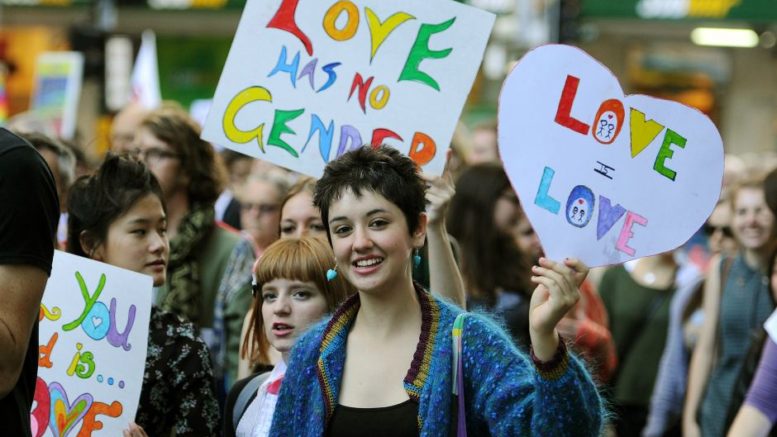On June 26, 2015, gay rights activists rejoiced as the Supreme Court ruled that marriage was a basic right that included same sex couples. Those who protested the ruling did the opposite, holding up signs saying, “Kids do best with a mom and dad!”
Gay rights is a divisive social issue among Americans. A poll conducted by Pew research in 2016 concluded that 55% of Americans support gay marriage. This split between American beliefs causes widespread discrimination towards the LGBTQ community, but this is certainly not the beginning. The fight against this discrimination spans across decades.
The Supreme Court ruling that made gay marriage legal in America began with Jim Obergefell and his partner John Arthur. The couple had been married in Maryland, however their marriage was unrecognized in their home state of Ohio. What made matters even more urgent for the couple was the fact that Arthur was diagnosed with ALS, and was not expected to live for more than a few months. The goal of Obergefell and Arthur was to have their marriage recognized on Arthur’s death certificate. This case along with six other cases of similar requests were presented to the Supreme Court. The Court ruled in favor of Obergefell by one vote. The vote came down to Associate Justice, Anthony M. Kennedy, a moderate on the supreme court who said, “A first premise of the Court’s relevant precedents is that the right to personal choice regarding marriage is inherent in the concept in individual autonomy.”
However, LGBTQ rights are not only debated in America. Just a year before the Supreme Court ruling in America, England legalized same-sex marriage. The debate in England is centered mainly on the fact that the country has an established religion, The Church of England or Anglican. Under the Church of England, the monarch is the supreme governor. This brought some conflict to the matter, as the Queen of England had been reported to be against lifting the ban on same-sex marriage. Although the leadership of The Church of England was against the cause, the Same-Sex Marriage Act was proposed and passed. However, this act also includes points that ban Anglican churches from marrying same-sex couples, even when a specific church may support it.
America is not rid of LGBTQ discrimination either. Although it is legal for people of the LGBTQ community to marry whomever they please, 29 states have not implemented anti-discrimination laws in terms of employment. This means that an employer can refuse to hire someone or that person can be fired for their sexual orientation, financially disadvantaging those who identify as part of the LGBTQ community. According to UCLA school of law, those who identify as transgender are twice as likely to be unemployed than an average American. This results in a substantial amount of poverty among the LGBTQ community.
Stances on LGBTQ rights seem to vary based on geographical location. States in the south such as Texas, Oklahoma, Alabama, Arkansas, Mississippi, Florida and Georgia tend to be more conservative on the subject. In this case, these states only prohibit job discrimination against public employees for their sexual orientation. This excludes discrimination against their gender identity. An openly gay student at Westhill, Will Bruno (’17), said, “I am very lucky in that I live here, in the northeast, where there is a very liberal climate socially and politically. If I were to move to the Deep South, I would have to put my economic prosperity first. If my gayness was precluding me from having a prosperous life, then I would have to fight that.”
Healthcare is another hurdle for the LGBTQ community, specifically for the transgender population. Going through complete gender transformation is a medical process; it requires therapy, doses of hormones, and surgery. However, because these procedures are not brought to most physicians on a regular basis, many doctors lack experience and knowledge of these medical practices. In a poll from the American Medical Student Association, 29 % of transgender people reported having to teach their healthcare provider about transgender health issues. A problem also arises when doctors choose not to treat transgender patients. Whether for religious political reasons, there have been several cases in which a medical professional has refused to treat a patient because they were transgender. A National Transgender Discrimination Survey conducted reported that 19 % of transgender people had been denied care. This fact, along with the findings that transgender people have a very high rate of depression as well as the HIV infection make for several medical barriers for those who choose to undergo gender transformation.
America stays consistently divided on their views of LGBTQ rights. However, Westhill has taken steps in favor of transgender students with the new gender-neutral bathrooms put in place. The bathrooms can be used by anyone, but they are meant to give those who identify as a different gender than the one on their birth certificate a safe space.
Roughly half of Americans do not believe that same-sex marriage should be legal, with 72 countries having outright outlawed homosexual activity. Even though there is very strong opposition, there are approximately 9 million people in the United States who identify as part of the LGBTQ community. Regardless of personal belief, people under the LGBTQ community face specific struggles, struggles that the significant majority of America’s population will never have to endure.

